Workplace discrimination impact on employees
- 32 Pages
- Published On: 09-11-2023
Chapter 1: Introduction
1.1. Background/Research Topic
In the current period, society is in a much fairer position where people are protected. Despite the fact discrimination at the workplace still exists in many organizations and is a matter of concern, HRM dissertation help. Discrimination occurs when the employees or staff are treated unequally or unfavorably due to certain factors. These factors are gender, age, race, caste, religion, disability, ethnicity, and skin color. Apart from the stated factors, there are other causes of discrimination in an organization, such as flawed management system, workforce diversity, organizational structure, flawed administrative system, corporate politics, and lack of decision-making (Halley et al., 2018). In this regard, it can be highlighted that in Tesco Plc, employees belonging to different ethnic communities work together, such as African and South Asian, among others. The employees in Tesco Plc face discrimination from the higher authorities regarding getting any benefits in contrast to the UK born employees of the organization. Therefore, it is apparent that workforce diversity is one of the prime causes of workplace discrimination at Tesco Plc. Apart from this, the employees have differences in educational background, culture, values, and beliefs. These factors contribute to differences of opinion and can act as a negative factor causing employee conflicts and more workplace discrimination. Discrimination in ate workplace develops a hostile work environment, and that results in low productivity, low professionalism, and ultimately interferes with organizational output and reputation in the long run. Thus, in this regard, it becomes vital for Tesco Plc to develop specific strategies that would help in promoting a fair workplace environment and equality at work, thus improving the management and organizational productivity (Dhanani et al., 2018; Berrey et al., 2017)
1.2. Research Aim and Objectives

The prime aim of this study is to discuss on workplace discrimination in Tesco Plc and its impact on the workforce and the work environment of this company.
- To analyze the factors creating workplace discrimination
- To detect the impact of workplace discrimination on the employees and the organization
- To find the link between workplace discrimination and workforce diversity
- To evaluate how workplace discrimination affects workplace ethics and equality
- Finally, to recommend a few useful strategies that Tesco Plc can use to eliminate workplace discrimination and maintain diversity and equality in its workplace.
1.3. Rationale for the Research
In the current scenario, most organizations offer a better workplace to the employees where they are treated equally and favorably. Despite this, there are cases reported where due to differences in race, caste, religion, gender, ethnicity, and disability, many employees face discrimination. In this study, Tesco Plc, one of the well-known supermarket chains in the UK, has been considered for studying workplace discrimination and its impact. Research in this area would be relevant in gaining knowledge about workplace discrimination and its effects on productivity and reputation of the organization as well. Besides, the topic is necessary for future researchers to understand the factors restricting diversity and equality at the workplace. The research would be useful for organizations, people as well as the community in understanding the impact of workplace discrimination on the motivation level of the employees and productivity of the organization, along with strategies to improve them in the future.
1.4. Research Questions
Based on the research aim and objectives, the following research questions have been designed to answer this study.
R1. What does workplace discrimination mean in a broader sense?
R2. Which factors are responsible for workplace discrimination?
R3. How is workplace discrimination associated with poor implementation of equality and diversity in the workplace?
R4. What are the possible impacts of workplace discrimination on an organization and its employees?
R5. What strategies can Tesco plc take to eliminate workplace discrimination and maintain equality and diversity in its workplace?
Chapter 2: Literature Review
2.1. Factors Associated With Creating Workplace Discrimination
The term ‘discrimination’ can be defined as treating individuals unequally. Workplace discrimination occurs when employees or staff are discriminated against at the workplace based on certain factors. In this regard, Doyle (2020) has highlighted that factors causing discrimination are the workplace are retaliation, disability, race, sex, age, national origin, color, and religion.
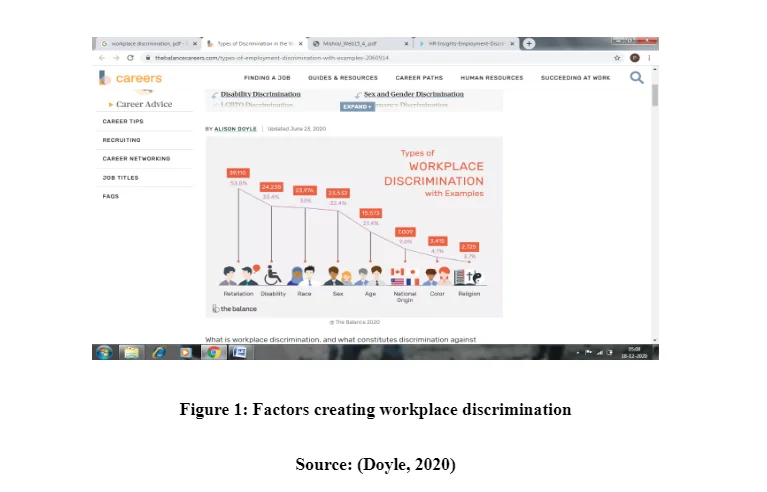
Apart from the factors highlighted in figure 1 above, other reasons can be employees discriminated due to relationships with another individual at the workplace.
According to Mishra & Mishra (2015), it has been highlighted that in the fastest growing economy, age and obesity are considered the most vital factors for discrimination in the workplace. The age-based discrimination has increased to 77% from 2005 to 2008. In this regard, several explanations have been put forward that are causing age discrimination in the workplace, such as low productivity among the older workers, lack of creativity, less ambition, and difficulty in training. Another reason for racism that is common among the public of the USA is overweight. In the area of employment, overweight Americans are frequent victims facing discrimination in the workplace. Employers hesitate to recruit overweight individuals as they think that they would reduce productivity and are less efficient than other employees. Age and obesity discrimination is the type of stereotype that creates a hostile environment and should be eliminated for the organization's growth (Mishra & Mishra, 2015).
2.2. Impact of Workplace Discrimination on Employees and the Entire Organization
Discrimination in the workplace is a severe problem faced by the employees. One of the expected impacts of racism is the victim has to deal with emotional issues. Individuals who face discrimination feel stressed at work. This would increase their anxiety level and thus the need to take medication. The overall situation is likely to impact the health and wellbeing of the employees. Another profound impact of workplace discrimination is that the victim faces difficulty in communicating with co-workers. This, in turn hurts the work output of the employee and ultimately leading to stress (Regmi et al., 2009). The workers of Tesco Plc are facing age and pay discrimination at the workplace. Legal action was taken by 17 workers of the company due to deliver reduction among the long-time working employees since 90s. Approximately 38,000 workers have been affected due to this pay cut, which was also age-based as long time working employees were mostly affected. This has impacted their lifestyle and financial planning. Besides, it was believed that the loyalty of the workers had been disregarded by the employers. Thus, discrimination has caused stress in workers' lives (Nationwide Employment Lawyers Ltd, n.d.).
Continue your journey with our comprehensive guide to Stress and Conflicts at Work Places.
Discrimination affects the performance level of the employees and thus impacts the productivity of the organization. Employees experiencing regular workplace discrimination are more likely to leave the organization and thus increases the turnover rate. Comparing the annual number of Tesco Plc 2015 to 2020, it can be highlighted that the turnover rate has increased. In 2015 it was 517,802 and reduced to 423,092 in 2020 (Figure 2). The annual growth rate of the company is also negative (Figure 3). These factors indicate that the workers' discrimination has impacted the overall performance of the company that has been apparent from the turnover and growth rate, respectively (Macrotrends LLC, 2020).
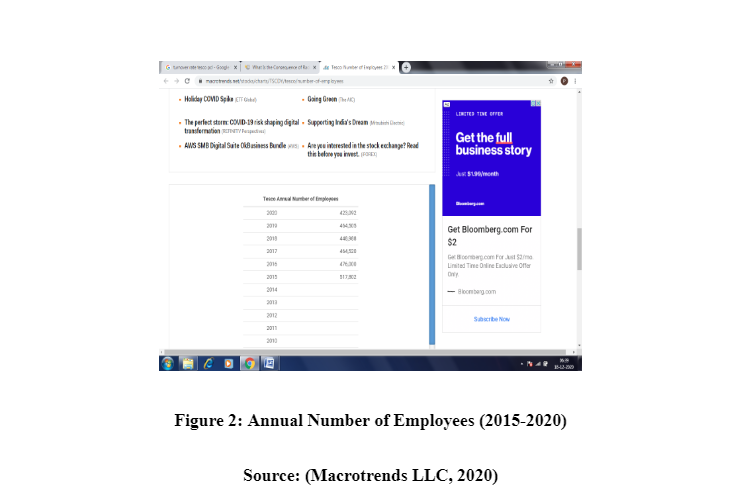
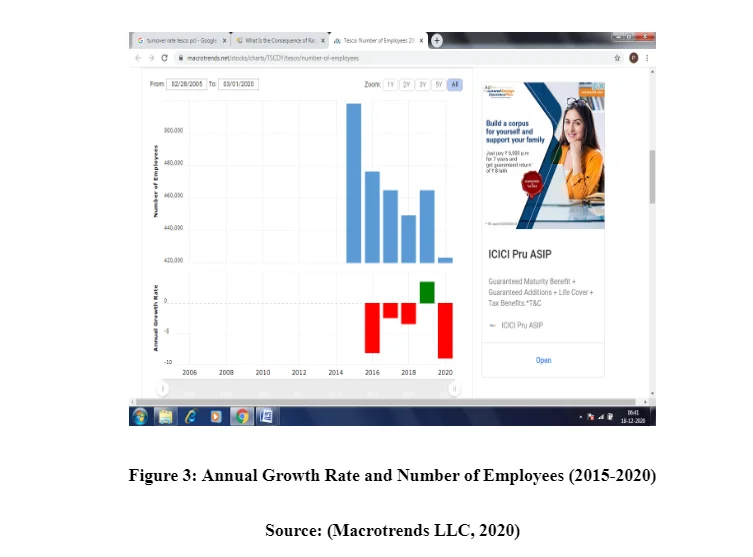
2.3. Link between workplace discrimination and workforce diversity
Diversity distinguishes one individual from the other. This distinction is based on gender, ethnicity, culture, religion, family, age, social status, and spirituality. Discrimination is when an individual is treated differently because of the stated factors. In today’s world, the workforce's diversity is one of the significant factors that contribute to the long-run success of the organization. In this regard, it has been stated that a lack of workforce diversity in the workplace is likely to promote more discrimination in the workplace. In this regard, it can be highlighted that if a company hires people with similar diversity that is the same ethnicity, educational background, professionalism and talent will develop specific common standards for success in the organization. In this case, workers with different backgrounds would feel isolated in the work environment and thus increasing pressure on them. In this regard, having a diverse workforce in the organization would help fight discriminatory behavior in the work environment and reduce harassment (International Labour Organization, 2016; Kim, 2008).
2.4. Workplace discrimination affects workplace ethics and equality
The term ‘equality’ refers to fairly treating individuals despite differences in gender, race, religion, disability, nationality, and age. Equality in the workplace is associated with providing equal opportunities to the employees in terms of pay and facilities. The organizations should provide a conducive environment at the workplace where the people would feel happy. Ensuring equality in the workplace reduces the chances of discrimination in the workplace. In this regard, it can be highlighted that the incident of discrimination at the workplace affects equality as the employee starts to feel isolated and different from others, thus reducing their morality. Therefore, companies that embrace equality at work are likely to outperform others. Workplace ethics, on the other hand, is the set of standards that is followed by the employees as well as employers. Discrimination at the workplace impacts the set of standards followed as it directly affects the relationship between the employees and overall reduces the organization's performance in the long run. Also, discrimination at the workplace impacts the employees' behavior and thus not meeting the standards of ethical conduct. Therefore, in this regard, it becomes the responsibility of the organization to take the necessary steps to maintain equality and workplace ethics for retaining the performance of the organization (Furxhi et al., 2016).
Chapter 3: Research Methodology
3.1. Research Philosophy
According to the Research Onion Model, research philosophies are the principles based on which the research is conducted. In academic studies, there are three types of philosophical positions that are positivism, interpretivism, and realism. In this study, research conducted is based on the positivism philosophy. Positivism philosophy has been used because it is more scientific, and knowledge gained using this is considered independent of the subject selected. Also, positivism philosophy is helpful for the researchers to test different phenomena based on the information gathered from natural events. Furthermore, using this philosophy has enabled the researcher to gain authenticated data and sources that are ultimately helpful in achieving the desired research outcome (Schwaferts, n.d).
3.2. Research Approach
Once the philosophy is chosen, the onion model suggests selecting an appropriate research approach for the study. There are two types of research approach that is deductive and inductive. The reasoned approach requires developing a hypothesis based on the secondary literature analyzed and then finally testing the hypothesis. On the other hand, the inductive process involves observation based on which a new theory is developed (Burney and Saleem, 2008; Schwaferts, n.d). In this study, a deductive research approach has been used. The reasoned approach has been preferred as this approach enables using the existing information and theories in achieving the research aim. Also, the deductive method helps analyze the current ideas and models that help to gain an in-depth understanding of workplace discrimination at Tesco Plc. On the other hand, the inductive approach is not used to develop new theories and hypotheses.
3.3. Research Design
The main aim of the research design is to make sure that the information gathered is useful in answering the research questions. In this regard, it can be highlighted that the three types of research design are descriptive, exploratory, and explanatory. In this study, the superior and experimental research design has not been used as it requires exploring new ideas and thoughts that are time-consuming. In this study, descriptive research design has been used. Descriptive research design has been effective in analyzing the information gathered from the secondary sources and interpreting them effectively for gaining appropriate answers to research questions (Kabir, 2016; Cropley, 2015; Wyk, n.d). Besides, a descriptive research design helps the researcher understand work discrimination and its impact on the employees and the organization. Therefore, the descriptive research design has been efficient in meeting the research objectives.
3.4. Research Method
The research method is an integral part of the methodology and depicts the procedure for collecting data. In this regard, the two ways are qualitative and quantitative method. The quantitative research method is used to test theories. This involves the use of numbers and statistics. On the other hand, the qualitative research method enables developing understanding concerning the research topic. This involves in-detailed description (Wyk, n.d). In this study, both the qualitative and quantitative research method has been used for gaining preliminary information about workplace discrimination in Tesco Plc and its impact on the employees and organization.
3.5. Data Collection Method Analysis
Data collection is collecting and gathering data from different sources to gain relevant information to answer the research questions. The data collection method can be categorized into primary and secondary data collection methods. Preliminary data can be defined as raw data collected. On the other hand, secondary data are previously collected by other researchers (Ajayi, 2017; Schwaferts, n.d). In this study, both primary and secondary data collection method has been used. In this regard, to collect preliminary data, surveys and interviews have been conducted among the selected participants. For the survey ex-employee of Tesco Plc has been chosen. On the other hand, the talk has been conducted among the different Tesco Plc managers from various departments. In this study, a random sampling method has been used to select the respondents for the survey and interview to collect relevant data for the analysis. For the survey, 60 ex-staff were selected who were given close-ended questions to gather necessary feedback. On the other hand, for an interview, five managers from different departments were interviewed, and their responses were recorded. The data collected from the survey is analyzed using graphs, charts, and tables. Besides, data collected from the interview is analyzed and justified using secondary information to gain in-depth knowledge about workplace discrimination at Tesco Plc and its overall impact on the organization.
3.6. Ethical Considerations
The participants in the study will be informed about the research study by giving the details in an e-mail. The information also highlights the risks associated with the research and the expected outcome. Also, written consent has been taken from the participants of the survey and interview. The participants were also given the option to withdraw from the study and talk if they wish to at any time. Moreover, the Data Protection Act 1998 has been followed in the study for data storage and security. In this regard, personal data and information of the participants have been kept confidential. The data collected was stored in the University data repository that is secured with password protection and software.
Chapter 4: Findings
4.1. Survey Findings
To understand about possible discrimination in the workplace, a questionnaire survey has been conducted with 60 ex-employees of Tesco. Among the 60 employees, 35 are female, and 25 are male employees. The respondents are asked how long they have been employed in the company. On this question, most of the respondents (34 out of 60) have stated that they have been used in the company for 6 to 10 years. 17 respondents have indicated that they are being employed in the company for 3 to 5 years and 6 respondents stated they are being used for more than 10 years (see the following figure).
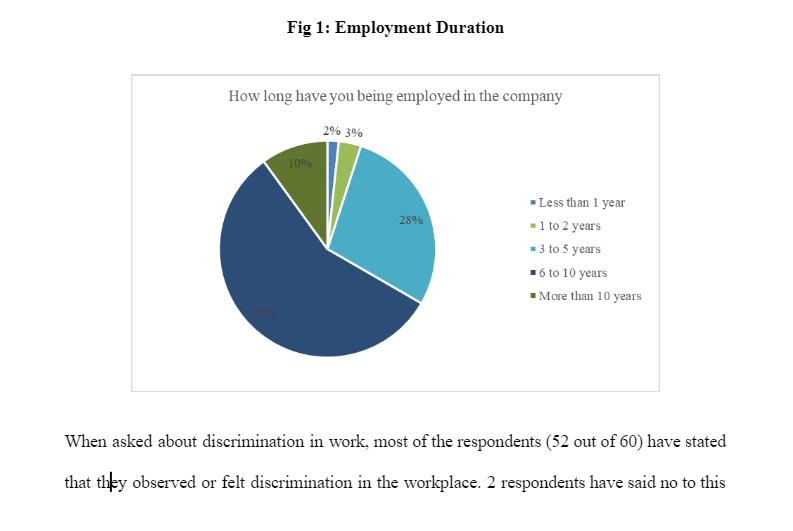
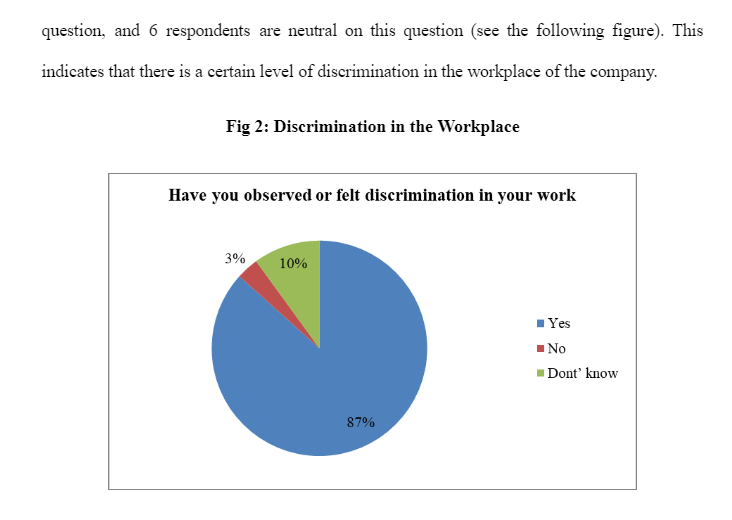
To understand the ground of discrimination, the respondents are asked which basis they have felt or observed bias in the workplace. On this question, most of the respondents (50 out of 60) have stated gender as a critical basis of discrimination. 49 respondents have stated age as a crucial basis of discrimination. 32 respondents have stated sexual orientation as a vital basis of discrimination. These are the top three bases of discrimination in the workplace observed by the respondents. Apart from that, 28 and 22 respondents have observed discrimination based on ethnicity and religion (see the following figure).
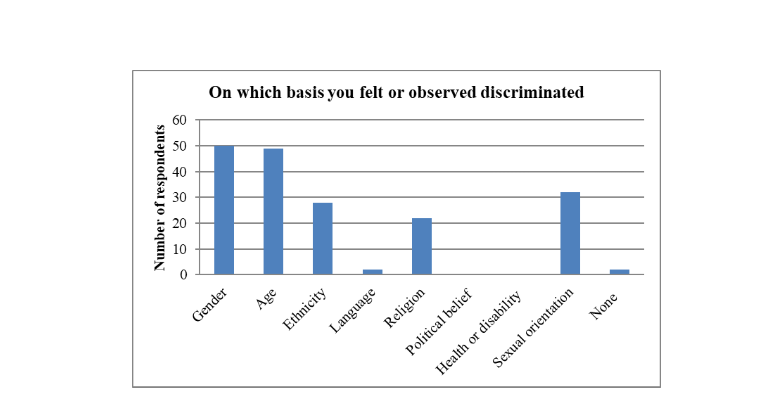
To understand more about the discrimination, the respondents are asked about the area they have experienced discrimination. On this question, most of the respondents (52 out of 60) have stated they felt discrimination according to working hours. 51 respondents indicated that they thought discrimination on wages or salary, and 50 respondents indicated that they thought about career development. These are the top three areas of discrimination in the workplace. Apart from that 32 and 23 respondents respectively stated that they experienced discrimination on duties and responsibilities and worked support respectively (see the following figure).
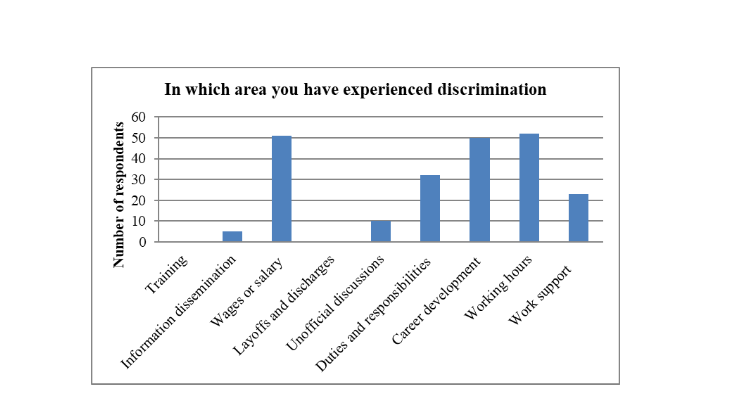
In the next question, the respondents are asked from whom they perceived the most discrimination. On this question, 52 respondents have stated that they perceive discrimination from the immediate supervisor. On the other hand, 5 respondents have said they perceive discrimination from the senior employees, and only 2 respondents stated they perceive discrimination from the co-workers (see the following figure).
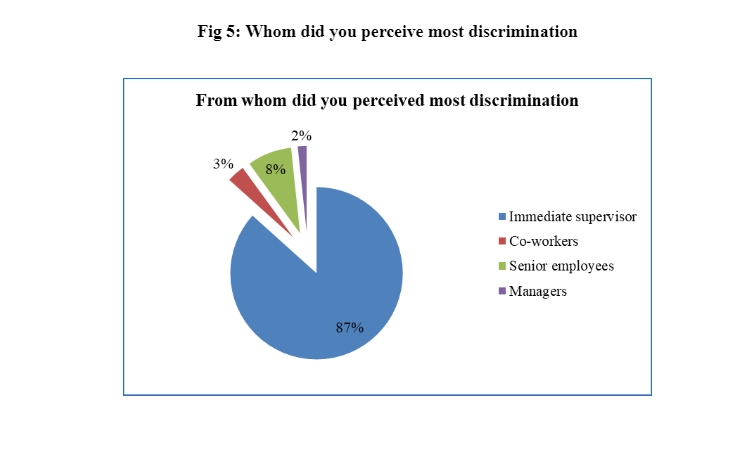
The respondents are asked if there is an effective grievance mechanism in the company to address discrimination. Most of the respondents (50 out 60) mentioned that the grievance mechanism for addressing racism in the workplace is ineffective. 6 respondents are neutral with this fact, and only 2 respondents said the grievance mechanism in the company as practical (see the following figure).
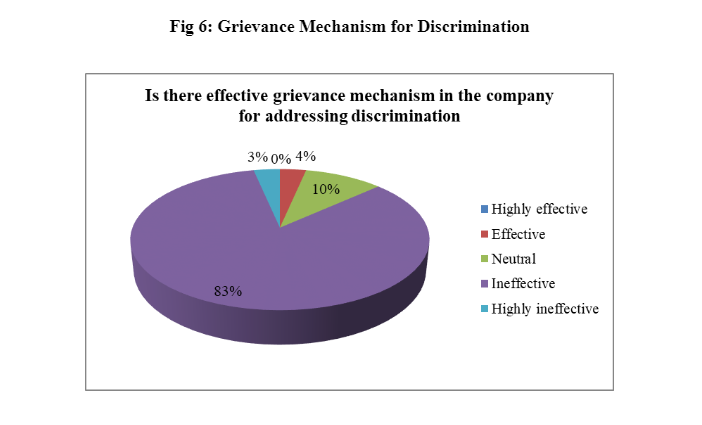
Top management support is essential to deal with discrimination in the workplace. Therefore, the respondents are asked how actively the top management of the company intervenes in discrimination. On this aspect, most of the respondents (51 out of 60) have stated that they interfere to a certain extent. 5 respondents also said that they do not intervene at all. Very few respondents (only 2) noted that the top management intervenes actively (see the following figure).
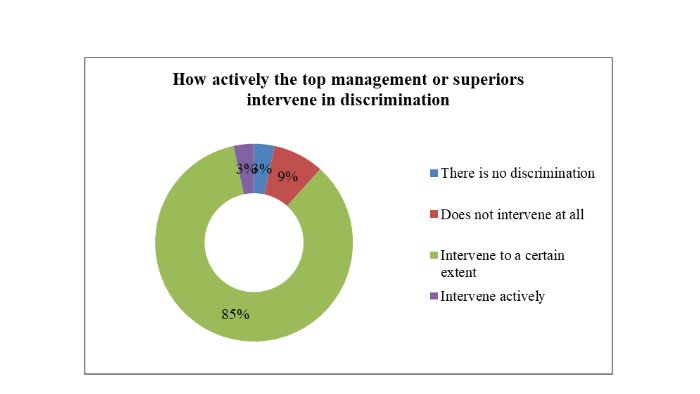
To understand how workplace discrimination is associated with diversity, the respondents are asked how well the diversified skills of employees are utilized in the company. On this question, most of the respondents (45 out of 60) stated not well. 10 respondents have noted that the diversified skills are used moderately, and 2 respondents have said that the diversified skills are used well in the company (see the following figure).
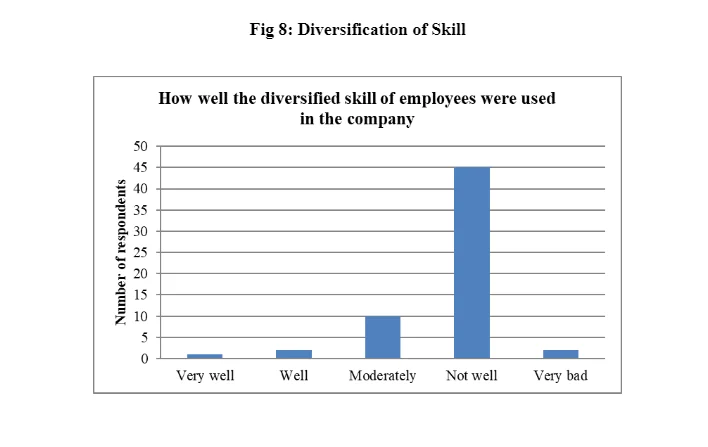
To understand the impact of discrimination on the employees, the respondents are asked if they enjoy coming to work. On this question, most of the respondents (35 out of 60) are neutral because they want coming to work. 15 and 9 respondents respectively agreed and disagreed with this fact (see the following figure).
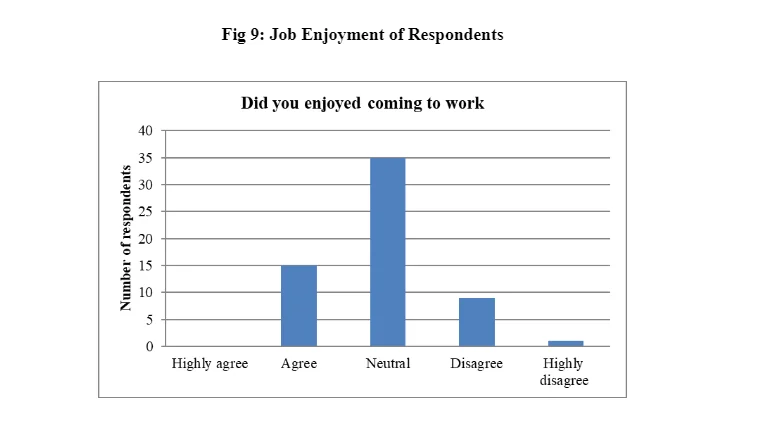
The respondents are asked about how satisfied they are with their job. On this question, the majority of the respondents (36 out of 60) were neutral. 12 and 9 respondents have demonstrated satisfaction and dissatisfaction with their job (see the following figure).
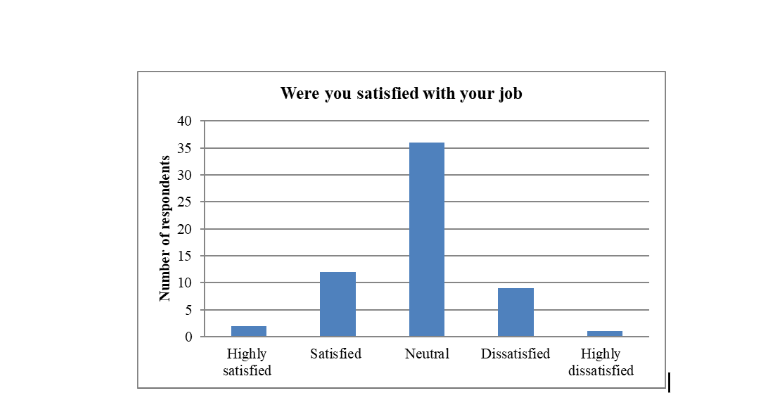
Finally, the respondents are asked if they consider discrimination has any impact on organizational performance in terms of profitability. On this question, most of the respondents (31 out of 60) have agreed with this fact. On the other hand, 25 respondents also disagree with this fact. 4 respondents were neutral on this question (see the following figure).
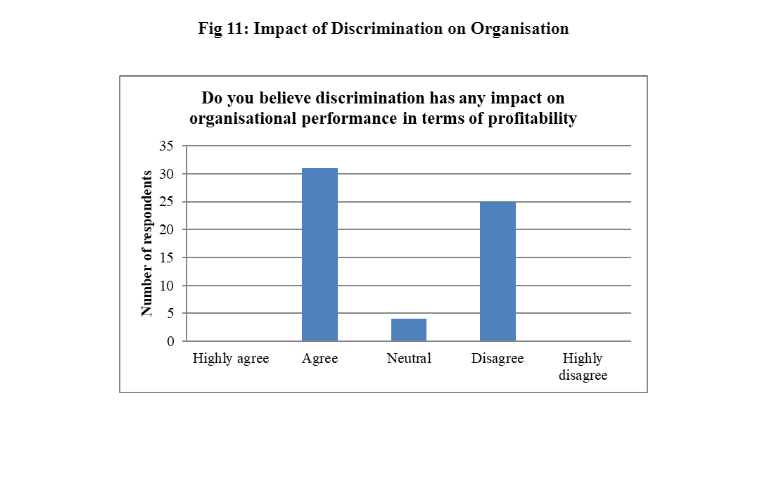
4.2. Interview Findings
4.2.1. Factors creating workplace discrimination
This study has taken an interview with 5 managers from five different Tesco Plc departments, wherein 5 open-ended questions were asked to them. When the first question we're asked to the respondents regarding the factors creating workplace discrimination that it was found that the majority of them stated that discrimination in the workplace takes place when some individual is treated in a lesser favorable manner as compared to other employees. It was even presumed by some of the respondents that discrimination even takes place when specific rules and regulations give disadvantages to some of the staff members. Respondent 2 stated that “I feel like treating one of the employees in a lesser favorable manner due to its age, religions, sexual orientations, genders, etc. acts as major discriminator factors in the workplace.”
4.2.2. Impact of workplace discrimination on employees and the entire organization
When the respondent was asked regarding the impact of workplace discrimination on employees and the organization as a whole than it was analyzed that the majority of the respondents stated that it brings communication gaps in between the co-workers. They even noted that discrimination also results and brings about inequalities and leads to a decline in the employees' morale. It also increases the turnover rates and declines the level of commitment. The drop in confidence of the employees thus leads to a deterioration of their performance. This results in lessening the profitability of the company. Respondent 5 stated that “As per my experience, discrimination separates the people from one another and decline their emotional capabilities which further slow down their performance level.”

4.2.3. Linkage between workplace discrimination and workforce diversity
When the responses of the respondents were analyzed regarding the linkage between workplace discrimination and workforce diversity than it was reviewed that diversity helps the organization to decline the level of discrimination. It was analyzed that diversity is key to success in an organization as it brings variation and distinction in the workplace that includes genders, culture, religion, spirituality, etc. They also stated that a diverse workforce assists in dealing with discriminatory behavior and decline the harassment levels. Respondent 1 said that “according to me, diversity assists the organization in dealing with discrimination level easily.”
4.2.4. Impact of workplace discrimination upon workplace ethics and equality
When the respondents were asked how workplace discrimination affects workplace ethics and equality, most respondents stated that discrimination negatively affects ethics and equality in the workplace. It is analyzed that racism does not provide equal opportunity and facilities to every individual. Moreover, discrimination also disbalance organizational ethics, whereby it isolates employees from one another and face administrative issues and harassments. Respondents 3 stated that “I have witnessed that workplace discrimination drastically affects ethics and equality as it isolates the people from other co-workers and disturbs the whole work environment…”
4.2.5. Strategies to deal with workplace discrimination
When the respondents were asked how to deal with workplace discrimination, the company should educate the employees regarding the legal rights and implement policies regarding intolerances. Training and various seminars should be organized in an organization that expresses how to deal with workplace harassment and discrimination. It was also analyzed that strict actions should be taken upon those who discriminate against others whereby officials’ reports should be filed in severe cases. In these responses, respondent 4 stated that ‘As per me, training and strict regulations can be fruitful in effectively dealing with these issues.’
4.3. Research Outcome
From the research survey, it can be observed that there is a certain level of discrimination experienced and observed by the respondents while working in the company. Most of the bias is faced based on gender and age. The discrimination mostly occurs in working hours, wages and salary, and working support. The immediate supervisors of the respondents are, most of the time, discriminates the workforce. Besides, the research reveals the fact that there is an ineffective grievance mechanism in the organization to address discrimination. The top management of the company has been found to intervene in discrimination only to a certain extent. Due to bias at times, the diversified skills of the employees were not used well in the company. This discrimination impacts job satisfaction and enjoyment of employees in work, and to some extent, in the organizational performance.
Chapter 5: Conclusion and Recommendation
5.1 Conclusion
The purpose of the study is to analyze how workplace discrimination impacts employees and the entire organization. It is interpreted that discrimination at the workplace declines the human capital and even creates the work environment for the employers and employees. Bias is found in promotion, hiring, termination, compensation, and job assignment. This practice takes in different forms and treats people differently, resulting in impairment of equality of treatment and opportunity. It is even reviewed that skills and competencies could not be developed, resulting in frustration and humiliations of the employees. When individuals feel that they are mistreated that they feel alienated, which negatively impact the work environment. Employees who face the issues of discrimination at work face trouble to interact with co-workers, even though if they are not causing the intolerance. This also declines the performance level of the employees. In addition to that, it is even found that workplace discrimination also deals with emotional problems. Higher stress, anxiety is some of the issues that impact the health and wellbeing of the people and ultimately to the performance of the workplace. It can thus be concluded from the whole study that execution of discrimination at the workplace leads to a hostile work environment and leads to lower professionalism, declination of reputation, and lower productivity of employees and organization.
5.2 Recommendation
It is recommended that the organization should conduct proper training facilities and even familiarize every manager and employee regarding discrimination laws. It is even suggested that labor acts, right civil acts are some of the rules that need to be adopted by every individual and organization. The company should even adopt their organization policies related to discrimination, and strict actions need to be taken for those who violate the guidelines and rules. It is even essential for the organization to take every claim seriously and conduct a proper investigation. Human resources management sectors should also not lose their sights while making decisions upon discrimination. It is further recommended that the company should give significant attention to equality and understand the factors that result in satisfaction. Managers should encourage the workers to stay committed and motivated towards the work. Companies should even strive for more robust leadership practices and conduct regular seminars and programs to prevent discrimination.
It is even recommended that managers of the company should supervise the allegations of unlawful discrimination upon the employees and should ask for penalties for contraventions. Compensation, injunctions, and reinstatements are also some of the interventions which can be applied by the organization against the employees who practice any sorts of discrimination in the workplace. It is also stated that promotions and rewards need to be given to every employee according to their workability, performance, and dedication. Favoritism should not be permitted in the organization, and the organization's satisfaction level needs to be upgraded among the employees by understanding their needs and desires. This will not only decline the discrimination level but will also uplift the performance level of employees.
5.3. Reflection and Recommendation of Alternative Research Methodology
At the initial stage, I was quite uncertain and nervous while choosing the research methods and the results and effectiveness. However, when I collected the data through my selected research methods, then I recognized that gathering both qualitative and quantitative data had helped me in attaining appropriate results. The interview has allowed me to study the non-verbal behavior of the people working in the company and has also provided me with flexibility. On the other hand, surveys have also assisted in studying the characteristics of a larger population and analyzing their results. It has also helped me to attain accurate data and honest response. Thus, it can be stated that although in the starting stage, I was quite uncertain regarding the output, this method has helped me in achieving the acquired results. In this study, I analyzed that I have good communication skills and could deal with people effectively. I have even reviewed that I also possess time management skills, wherein I could complete my work on time. However, I have considered that I could have only applied qualitative methods and took only interview findings as alternative research methods. The outcomes of the interview alone could have helped in attaining similar results. The usage of survey findings has consumed lots of time, which I could have used in other research chapters. In this context, it is stated that one can add more questions in the interview questionnaire and attain more data from those respondents.
Continue your exploration of Working with Young People with our related content.
References
Ajayi, O. V., 2017. Primary Sources of Data and Secondary Sources of Data. Benue State University, pp. 1-4.
Berrey, E., et.al., 2017. Rights on trial: How workplace discrimination law perpetuates inequality. University of Chicago Press.
Burney, S.M.A. and Saleem, H., 2008. Inductive and Deductive Research Approach. University of Karachi, pp. 1-2.
Cropley, A., 2015. Introduction to Qualitative Research Methods. University of Hamburg, pp. 1-2.
Dhanani, L.Y., et.al., 2018. Workplace discrimination: A meta‐analytic extension, critique, and future research agenda. Personnel Psychology, 71(2), pp.147-179.
Doyle, A, 2020. Types of discrimination in the workplace. [Online] Available at: https://www.thebalancecareers.com/types-of-employment-discrimination-with-examples-2060914 [Accessed 18 December 2020].
Furxhi, G., et.al., 2016. Job Discrimination and Ethics in the Workplace. European Journal of Multidisciplinary Studies, Vol. 1, No. 2, pp. 138145.
Halley, M.C., et.al., 2018. Physician mothers’ experience of workplace discrimination: a qualitative analysis. bmj, 363.
International Labour Organization, 2016. Promoting diversity and inclusion through workplace adjustments. [Online] Available at: https://www.ilo.org/wcmsp5/groups/public/---ed_norm/---declaration/documents/publication/wcms_536630.pdf [Accessed 18 December 2020].
Kabir, S.M.S., 2016. Methods of Data Collection.Curtin University, pp. 202-2018.
Kim, B.Y.,. 2008. Managing Workforce Diversity. Journal of Human Resources in Hospitality & Tourism, pp.69-90.
Macrotrends LLC, 2020. Tesco: Number of employees 2006-2020. [Online] Available at: https://www.macrotrends.net/stocks/charts/TSCDY/tesco/number-of-employees [Accessed 18 December 2020].
Mishra, B & Mishra, J, 2015. Discrimination in the Workplace. Journal of Higher Education Theory and Practice, Vol. 15(4), pp. 64-72.
Nationwide Employment Lawyers Ltd, n.d. Tesco workers claim pay discrimination. [Online] Available at: https://natemplaw.co.uk/portfolio/tesco-workers-claim-pay-discrimination/ [Accessed 18 December 2020].
Regmi, K., et.al., 2009. Understanding the effect of discrimination in the workplace: A case study amongst Nepalese immigrants in the UK. Emerald Insight, Vol. 28, Iss. 5, pp. 1.
Schwaferts.,n.d. Applying Saunders Research Onion. [Online] Available from: http://www.schwaferts.de/skripten/Saunders_Research_Onion.pdf[Accessed 17 December 2020].
Wyk, B. V., n.d.Research design and methods. University of Western Cape, pp. 1-11.
- 24/7 Customer Support
- 100% Customer Satisfaction
- No Privacy Violation
- Quick Services
- Subject Experts



